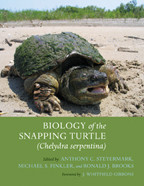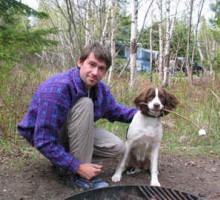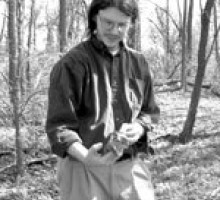The name "snapping turtle" conjures up images of powerful, prehistoric-looking beasts that lurk in the dark waters of local swimming holes. Beyond its status as childhood legend, Chelydra serpentina is one of the most interesting reptiles of the New World. One of our largest turtles, this animal weighs up to thirty-five pounds, lays as many as one hundred eggs and can deliver a nasty bite. Due to its wide distribution, abundance, and large reproductive output, the snapping turtle has become one of the most extensively studied species of reptiles.
This volume synthesizes all that is known about...
The name "snapping turtle" conjures up images of powerful, prehistoric-looking beasts that lurk in the dark waters of local swimming holes. Beyond its status as childhood legend, Chelydra serpentina is one of the most interesting reptiles of the New World. One of our largest turtles, this animal weighs up to thirty-five pounds, lays as many as one hundred eggs and can deliver a nasty bite. Due to its wide distribution, abundance, and large reproductive output, the snapping turtle has become one of the most extensively studied species of reptiles.
This volume synthesizes all that is known about the common snapping turtle to provide an up-to-date and comprehensive resource on the species' evolution, physiology, behavior, and life history. Anthony C. Steyermark, Michael S. Finkler, Ronald J. Brooks, and a team of experts detail the systematics, energetics, growth patterns, sex determination, and population genetics of snapping turtles and devote special attention to the fossil record of the snapping turtle family Chelydridae.
The first broad biological treatment of the common snapping turtle, this is the definitive reference for anyone working with or interested in this fascinating reptile.
Contributors: Ralph A. Ackerman, Iowa State University; Abdulaziz Y. A. AlKindi, Sultan Qaboos University; Barbara A. Bell, Drexel University; Ronald J. Brooks, University of Guelph; Justin D. Congdon, Savannah River Ecology Lab; Carl H. Ernst, George Mason University; Michael A. Ewert, Indiana University Bloomington; Michael S. Finkler, Indiana University Kokomo; Matthew K. Fujita, University of California, Davis; Eugene S. Gaffney, American Museum of Natural History; David A. Galbraith, Royal Botanical Gardens; Robert E. Gatten, Jr., University of North Carolina at Greensboro; Judith L. Greene, Savannah River Ecology Lab; J. Howard Hutchison, University of California, Berkeley; John B. Iverson, Earlham College; Fredric J. Janzen, Iowa State University; Jason J. Kolbe, Washington University; David B. Lott, Clarion University of Pennsylvania; Ibrahim Y. Mahmoud, Sultan Qaboos University; Don Moll, Southwest Missouri State University; Scott A. Reese, Kennesaw State University; Todd A. Rimkus, Marymount University; H. Bradley Shaffer, University of California Davis; James R. Spotila, Drexel University; David E. Starkey, University of Central Arkansas; Anthony C. Steyermark, University of St. Thomas; Gordon R. Ultsch, University of Alabama; Nigel H. West, University of Saskatchewan








